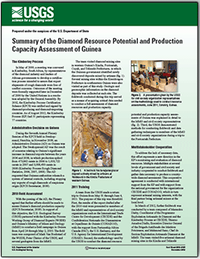In May of 2000, a meeting was convened in Kimberley, South Africa, by representatives of the diamond industry and leaders of African governments to develop a certification process intended to assure that export shipments of rough diamonds were free of conflict concerns. Outcomes of the meeting were formally supported later in December of 2000 by the United Nations in a resolution adopted by the General Assembly. By 2002, the Kimberley Process Certification Scheme (KPCS) was ratified and signed by diamond-producing and diamond-importing countries. As of August 2012, the Kimberley Process (KP) had 51 participants representing 77 countries. With the passing of the AD, the Plenary agreed that further efforts should be made to assess Guinea's diamond production capacity. In support of this objective, the U.S. Geological Survey (USGS) partnered with the Kimberley Process Working Group of Diamond Experts (WGDE) and Guinea's Ministry of Mines and Geology (MMG) to conduct a field campaign in Guinea from April 24 through May 2, 2010. The field team was composed of Mark Van Bockstael of the WGDE, Peter Chirico of the USGS, and several geologists from the MMG. The team visited diamond mining sites in western Guinea's Kindia, Forècariah, Coyah, and Tèlimèlè Prefectures, in which the Guinean government identified newly discovered deposits mined by artisans. Several mining sites within the Kissidougou Prefecture in southeastern Guinea were also visited as part of this study. Geologic and geomorphic information on the diamond deposits was collected at each site. The fieldwork conducted during this trip served as a means of acquiring critical data needed to conduct a full assessment of diamond resources and production capacity.


